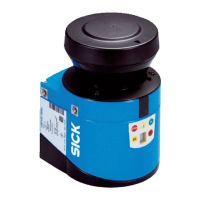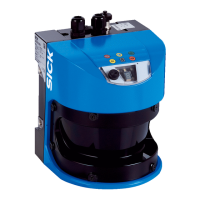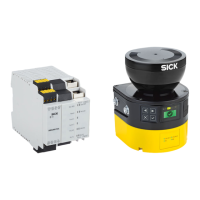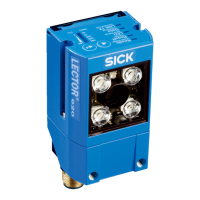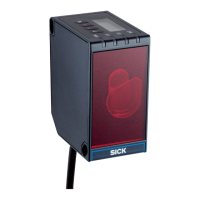The following incremental encoders with a push-pull output stage (HTL) can be used:
•
Single-channel, only connected at encoder A, no direction detection.
•
Dual-channel (phase), connected at encoder A and encoder B; the pulses have a
phase shift of 90°, making direction detection possible. By definition, during for‐
ward motion (CW = clockwise) phase A precedes phase B; conversely, during
reverse motion (CCW = counterclockwise) edge A rises before edge B.
•
Dual-channel (level), connected at encoder A and encoder B; the pulses are at
encoder A; at encoder B, the direction is indicated by level 0 or level 1 (rarely
used).
NOTE
Incremental encoder transmits a zero index signal often (encoder Z). This signal is not
processed by the device. So the signal does not need to be connected to the device.
NOTICE
Device damage due to incorrect parameterization!
•
When connecting an encoder, configure IN1/OUT1 of the device as an input.
3.5.4 Laser control
Laser control is used to switch the laser on and off. Measurement data is only transmit‐
ted when the laser is switched on. To initiate the transmission of measurement data,
the telegram command sEN LMDscandata 1 (hexadecimal:
73454E204C4D447363616E646174612001) , "Telegram structure", page 52 must be
sent once after switching on the device.
Since the motor turns constantly at the scan speed as long as the device is ready for
operation, the device is ready to start taking measurements immediately after the laser
has been switched on.
Laser control reduces the data load at the Ethernet interface. Switching the laser on
and off specifically when required also increases the service life of the laser diode.
The “switch-on delay” and “switch-off delay” parameters can be set to switch the laser
on subject to a time delay and/or to leave it switched on longer for a defined period
after the trigger signal has dropped out.
Following login (minimum Authorized customer), it is possible to select between various
modes on the Basic settings tab in SOPAS ET or using a corresponding terminal program.
In free-running mode, the laser is permanently switched on and the device detects
measurement data permanently (default setting). This mode is intended specifically for
test purposes or for aligning a device with the laser line.
The laser is switched off initially in software trigger mode. The laser is activated with the
Start measuring SOPAS command or the sMN LMCstartmeas telegram (hexadecimal:
734D4E204C4D4373746172746D656173). It is deactivated with the Standby command
or the sMN LMCstandby telegram (hexadecimal: 734D4E204C4D437374616E646279).
This mode is designed for the use of telegrams for triggering measurement data output
and for setting up the device with the SOPAS ET parameterization software.
In CAN trigger mode, laser control is based on CAN commands. This is standard prac‐
tice when using the device as part of a system with other SICK sensors.
PRODUCT DESCRIPTION
3
8023202/16S6/2020-01-24 | SICK O P E R A T I N G I N S T R U C T I O N S | LMS4400/LMS4500
17
Subject to change without notice

